 This story originally appeared on our sister site, Metaverse Health.
This story originally appeared on our sister site, Metaverse Health.
I’ve gone on ad nauseam about the benefits of virtual environments in regard to communal support around health issues. In the physical world, one of the most powerful support campaigns of the past 25 years is the AIDS quilt. Thanks to a joint initiative between Startled Cat and Jokaydia, that sucess story has moved into the virtual worlds of Second Life and Jokaydia’s OpenSim grid.
The premise is simple but powerful: ask those who have lost loved-ones to HIV/AIDS to commemorate those lost in a 3D version of a quilt. Like most of these things, you need to see it for yourself to get the power of it, but once you do it becomes obvious. I had a wander around the handful of quilt rooms already created and was impressed to saythe least – the overall build in Second Life is stupendous and easy to get around / navigate.
The launch of the 3D AIDS quilt occurred today and the call is now out for people to contribute.
For more information, go to either the website or check it out for yourself in Second Life.











Recent Comments